With this article, we wish Marry Christmas and a Happy New Year to all Croatian families worldwide,
as well as to all the people of good will.
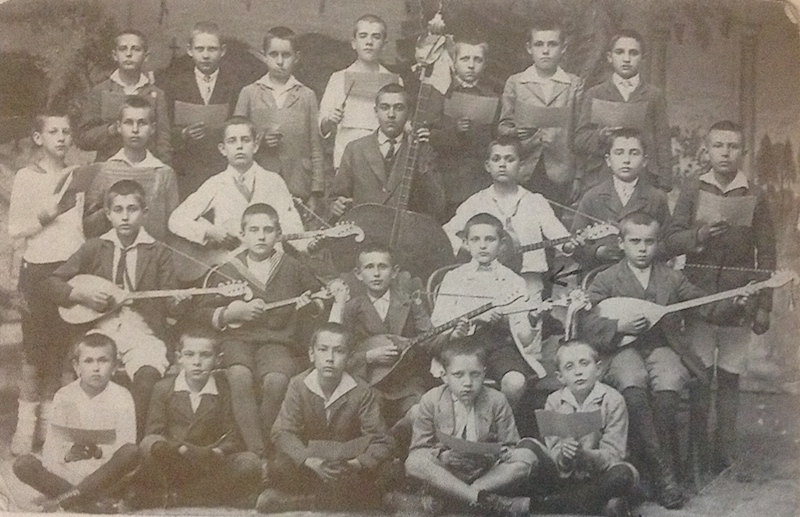
The town of Senj, Pjevačko tamburaško društvo Orlovo gnijezdo (Singing Tamburatza Society Eagle's Nest),
Ožegovićianum School in Senj, 1919/1920. In the second row, 2nd from the left, is Pavao Tijan
(distinguished Croatian lexicographer) playing bisernica. Source of the photo [Tijan].
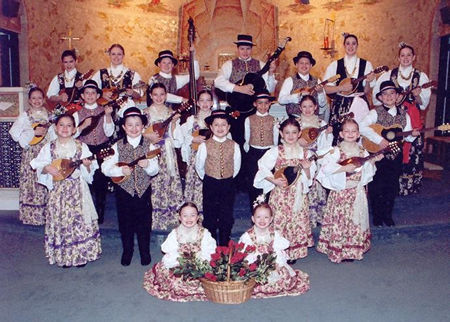
North Hills Junior Tamburitzans, USA
Several useful harmonic recepies The creation of this HTML has been motivated by the interest shown for our folk songs, that I noticed while browsing through the letters sent to the webmaster of the Croatian home page (mr. Josip Jurich). I provide my comments in English, since there are many Croats and their descendants throughout the world who do not speak Croatian any more, or only very little. 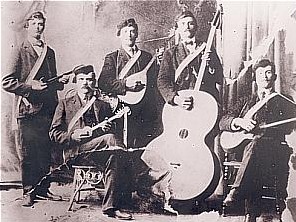
Croatian tamburitza band from Busevec near Zagreb,
performing in Cleveland, USA, in 1905 (Archives of Seljacke sloga - Busevec)
many thanks to Mr. Marinko Katulic for permission
Let me start with a very nice (and simple) song Ne dirajte mi ravnicu (listen to it!), which for sure will live among the Croats for many generations. 
Village of Samarica in Moslavina, North of Croatia
A word of caution for the Croatian reader: the tone or chord B is used in the meaning of the American notation, which differs from the Croatian: in Croatia we would write H instead of B. Thus the American B = the Croatian H, and
the American B flat (Bb) = Croatian B. The American notation, which we use here, is accepted also in some European countries, especially in jazz literature. 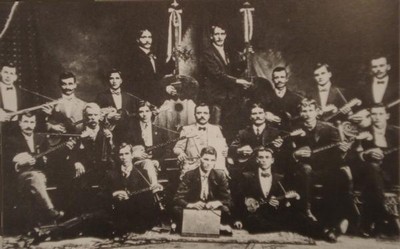
Boulder-based Croatian tamburica orchestra in Boulder, Western Australia, 1910s, see [Sutalo] Ne dirajte mi ravnicu 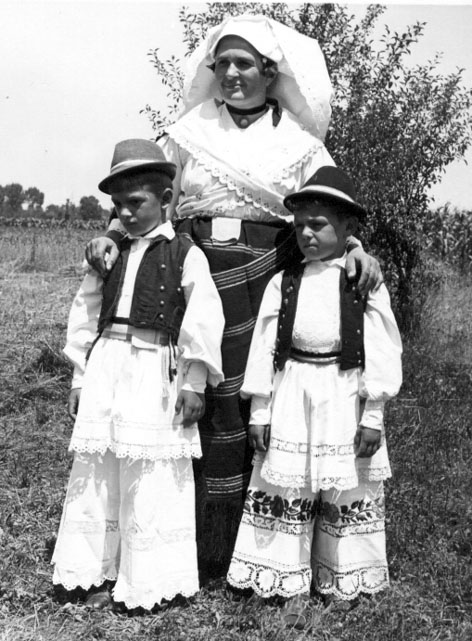 Miroslav Škoro Miroslav Škoro
G Am
1. Večeras mi dobri ljudi
D7 G
nemojte ništa pričati.
G Am
Neka suze mirno teku
D7 G
pa che manje boljeti.
Refrain (2x):
C D7
Ne dirajte mi večeras
G B7 Em Cm
uspomene u meni.
G Am
Ne dirajte mi ravnicu,
Am D7 G
jer ja ću se vratiti.
2. Mene zovu moja polja,
mene zovu tambure,
prije nego sklopim oči,
da još jednom vidim sve.
2xR.
3. Još u sebi čujem majku,
kako tužno govori:
"Kad se jednom vratiš sine,
ja ću te čekati."
2xR.
My deep gratitude for the above very nice authentic photo goes to Dr. Zdenka Lechner. The photo below I obtained by Mr. Ivo Lusic from South Africa. 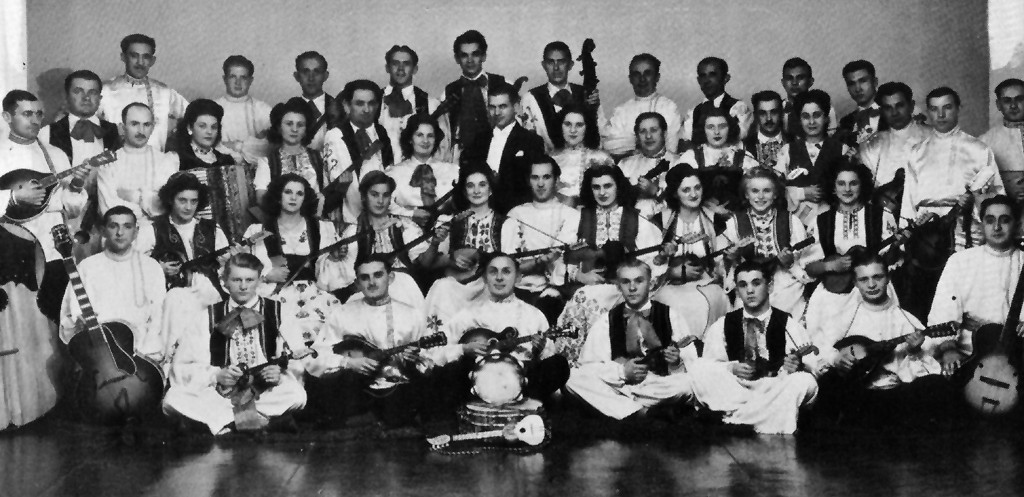
Croatian Tamburitza players from Johannesburg,
South Africa, 1940s
I shall try to describe some general principles that are useful for guitar accompaniment. Of course, all that follows applies to any other polyphonic instrument (piano, harmonica), not only guitar. I believe I have some "qualifications' after many years of amateur experience (I started to play guitar as a student). This manual (or rather a harmonic cook-book) is a gift four You, if You are a "beginner". Let me concentrate on two most important things for the guitar harmony: - back-cycling (in Croatian: ~odmotavanje),
- parallel chords,
without dwelling into cumbersome theoretical details. We strive to be practical oriented. Don't be scared with what follows. All this is quite easy if you have a minimum of patience. 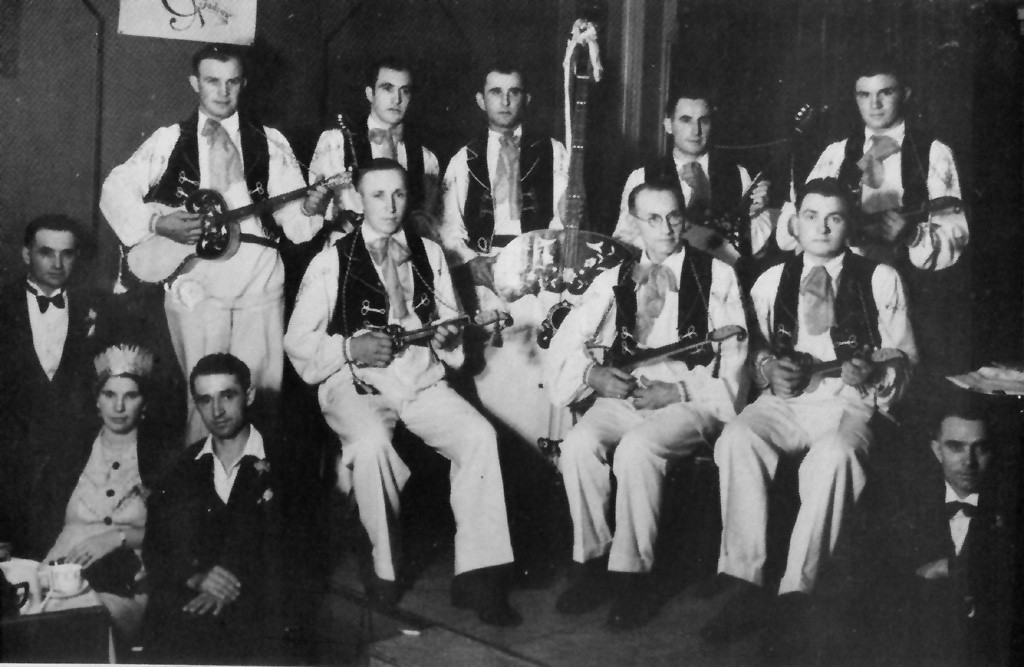
Croatian tamburitza orchestra Jadran
Johannesburg, South Africa, 1937
Comments There are three interesting harmonic points in this song: back-cycling, the role of B7 and Cm. - The Am (appearing above `ljudi') is a start of a well known harmonic mechanism called back-cycling (from G in our situation). If the tonic (to be defined below) is G major, we simply play two or three chords on the cycle of fourths (12 chords)
B -> E -> A -> D -> G -> C -> F -> Bb -> Eb=D# -> G# -> C# -> F# (-> B) preceding G, i.e.: A -> D -> G, or in our situation Am -> D7 -> G. In other words, we go BACK along the CYCLE of fourths. The above cycle of fourths, if read in the opposite direction (i.e. by reversing the arrows), becomes the cycle of fifths (quints). You will do a great thing in understanding your guitar play if you try to learn it by heart (this will not come just overnight). - For what follows we need a little preparation:
 Let us give a simple, practical definition of the parallel minor corresponding to some major chord. I'll give a geometrical definition based on the cycle of fourths. If we start say with the G major chord on the cycle of fourths, then we go three steps BACK to obtain E(m). So Em is the parallel minor chord corresponding to G. Similarly, the parallel minor of C is Am, of D is Bm etc. Let us give a simple, practical definition of the parallel minor corresponding to some major chord. I'll give a geometrical definition based on the cycle of fourths. If we start say with the G major chord on the cycle of fourths, then we go three steps BACK to obtain E(m). So Em is the parallel minor chord corresponding to G. Similarly, the parallel minor of C is Am, of D is Bm etc. - Less important, but often useful (especially for some songs from Meddimurje) is the notion of secondary parallel minor chord corresponding to a given major chord. We go one step more back on the cycle of fourths, i.e. four steps (instead of three). Thus for instance, starting from G, then going back four steps, we arrive to B(m), which is the secondary parallel minor of G.
- Conversely, if we start with say Em, then we say that G is the parallel MAJOR corresponding to Em. Similarly, G is the secondary parallel major corresponding to Bm.
- It is quite important to know the major chords and their parallel minors (and conversely). To summarize, we give a list of six most important triples of chords (in the natural order with respect to the cycle of fourths):
Parallel Secondary
Major chords minor chords parallel minors
E C#m G#m
A F#m C#m
D Bm F#m
G Em Bm
C Am Em
F Dm Am
For the remaining six cases you can try to find the corresponding tripples yourself. In any case, the pairs in the first two columns in the above table are the most important. - If you ever try to harmonize of a song, you first start with a cycle of fourths. Next you think about parallels that will fill a trivial harmonization.
- One more convention: if a song is harmonized in, say, G major as a basic tonality (the so called tonic), then its left and right neighbour on the cycle of fourths are called dominant and subdominant respectively.
- A very useful remark: if a song has a minor tonality, then for sure you must expect the chords corresponding to the tonality of the PARALLEL MAJOR to appear in the song.
- The role of B7 in this song is to connect G (tonic) and Em (the corresponding parallel minor). It is possible to omit it, but the accompaniment then loses a lots of its flavor. Note that B7 precedes Em on the cycle of fourths, so it can be considered as a `local back-cycling' from Em with only one step.
- The Cm can be viewed to have a subdominant role with respect to G (subdominant is C), and it can also be omitted (at the expense of the loss of a very nice harmonic drive). In practice most often Eb is used instead of Cm (Zlatni dukati). Note that the chord Eb (=D#) is just a parallel major to Cm. In my opinion, Cm is much better, and more in the spirit of the song.
- A small but nice variation is possible in the second line, and the corresponding lines in the song:
C D7 G
Nemojte ništa pitati
We have introduced C instead of D7. Here C is in fact a parallel major of Am. Through this variation of Am we proceed with backcycling: Am -> (C) -> D7 -> G. - A useful exercise for the beginner would be to play the whole song using trivial harmonization: G (tonic), D (dominant) and C (subdominant), and then to see how the above mentioned harmonic mechanisms ``fill in'.
- Exercise: try to harmonize the whole song starting with D as tonic (then try with C, A,...)
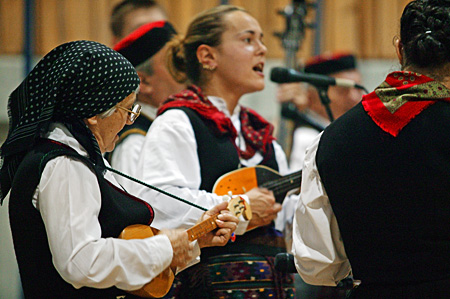
The Lika Night in Bazenheid, Switzerland
two generations of female players of tamburica from Lika

Village of Samarica in Moslavina 1936, North of Croatia
Croatian Christmas on Strawberry Hill, Kansas City, USA 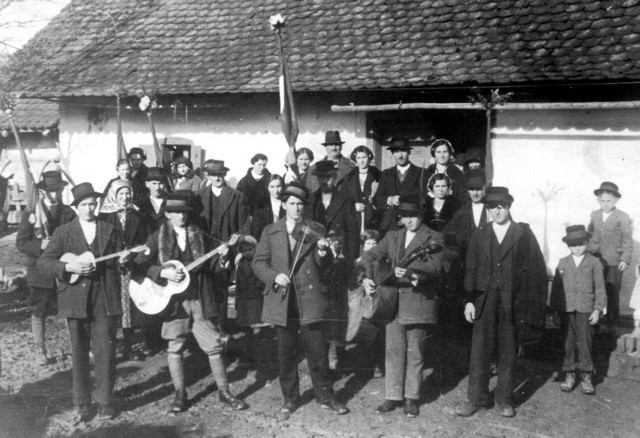
Village of Samarica in Moslavina, North of Croatia
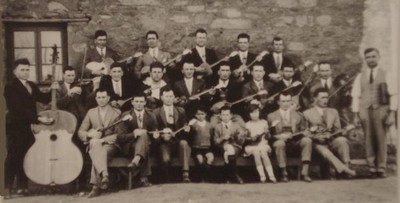
Broken Hill-based Croatian tamburica orchestra in Broken Hill, New South Wales, Australia, 1929, see [Sutalo]
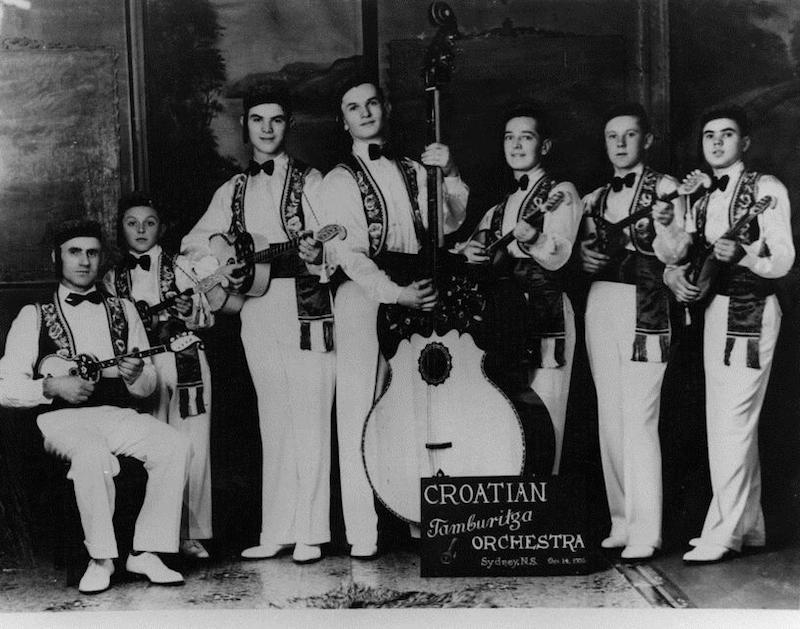
Croatian Tamburitza Orchestra in Sydney, 1930. Photo from Beaton Institute.
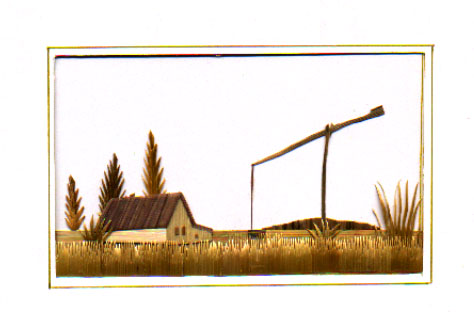 Let me add one of my favourite songs, a true jewel in both music and verses, very popular among the Croats and others in Baccka and Srijem. The harmonization below differs considerably from the usual one that we can hear on recorded materials, including also the interpretation of the famous orchestra of Janika Balazz, the uncrowned king of tamburitza (sedam tamburassa Janike Balazza). This Bogdan's song is written in ikavina dialect (for example "divojka, pisma"), typical Croatian dialect, now disappearing among the Croats in Backa (Bunjevci and Sokci), due to intensive serbization. Ikavian dialect is still very widespread also in Croatia and Bosnia and Herzegovina, and has a tremendous literature since the time of Marko Marulic (15th century). Let me add one of my favourite songs, a true jewel in both music and verses, very popular among the Croats and others in Baccka and Srijem. The harmonization below differs considerably from the usual one that we can hear on recorded materials, including also the interpretation of the famous orchestra of Janika Balazz, the uncrowned king of tamburitza (sedam tamburassa Janike Balazza). This Bogdan's song is written in ikavina dialect (for example "divojka, pisma"), typical Croatian dialect, now disappearing among the Croats in Backa (Bunjevci and Sokci), due to intensive serbization. Ikavian dialect is still very widespread also in Croatia and Bosnia and Herzegovina, and has a tremendous literature since the time of Marko Marulic (15th century). Već odavno spremam svog mrkova Zvonko Bogdan Dm Gm Dm G0 D0A7Dm C
1. Već odavno spremam svog mrkova,
F Bb F C C7 F A7
da se prođem ka-som od miline.
Bb E7 F D7 Gm C7 F A7
Da obiđem staze, staze svog djetinjstva, |
Dm Gm Dm C C7F A7 | 2x
Dm Gm Dm G0 D0 A7Dm |
za salašom želja da me mine. |
Refrain:
F C F
Neću više ići na tu stranu,
jer ne mogu suze oku skriti.
Nema više starog čardaka ni đerma, | 2x (the same
ni debela 'lada od bagrema. | harm. as above)
Ili moram tugom okrenuti glavu, | 2x (the same
il plakati ili se napiti. | harm. as above)
2. Nema više dobrih tamburaša,
fijakera, snaša, i salaša.
nema više konja, konja koji jure, | 2x
a u stvari nikuda ne žure. |
(without refrain)
3. Vrag nek nosi moje snove puste,
divojačke duge kose guste.
Vrag nek nosi tugom dobre tamburaše,
fijakere, pisme i salaše.
Refrain:
Neću više ići na tu stranu,
jer ne mogu suze oku skriti.
Ili moram tugom okrenuti glavu,
il plakati ili se napiti.
See also another Bogdan's beautiful song written in the Croatian ikavian dialect: Hej, salaši. Comments: - D0 = Ddim. Its usage often yields a very nice `sporadic' bass melody. You can also play A7 instead of D0.
- E7 is surprising, and sounds very nice. It connects the chords Bb and F. More precisely, the idea is to fill in the passage from Bb to F by using the chord diminished by ONE degree with respect to F: this is E7. In other words, we enter F from below. It is worth noting that it is precisely the seventh in the E7 chord, which gives the same tone as the one in the melody in the moment of usage!
- To see the meaning of this chord (E7), try to play the song without E7, i.e. with Bb instead.
- There is a lots of back-cycling here:
- C -> F,
- D7 -> Gm -> C7 -> F (look at the cycle of fourths above).
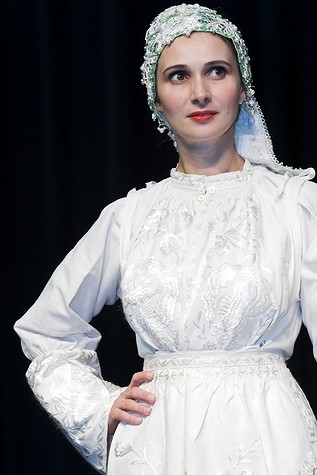
CroatiaFest 2005, Seattle, USA, Photo - Jal Schrof
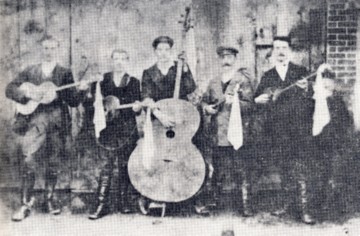
Croatian tamburitza orchestra from Virje, nicely decorated with white scarfs;
beginning of 20th century [Ivancan, p. 121]
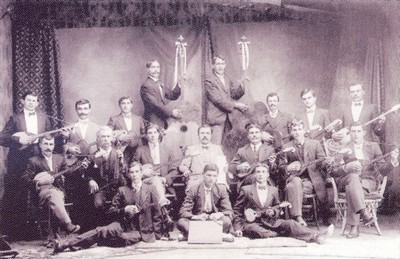
Croatian tamburitza orchestra in Australia, 1910
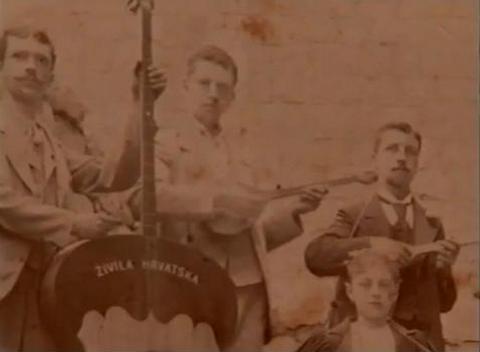
Tamburitza orchestra in Janjina on Pelješac peninsula,
with inscription "Živila Hrvatska" - "Long Live Croatia" on the bass.
Janjina is the birthplace of Miho Bjelovučić, father of the famous Ivan Bjelovučić who was the first in history to fly over the Alps in 1913,
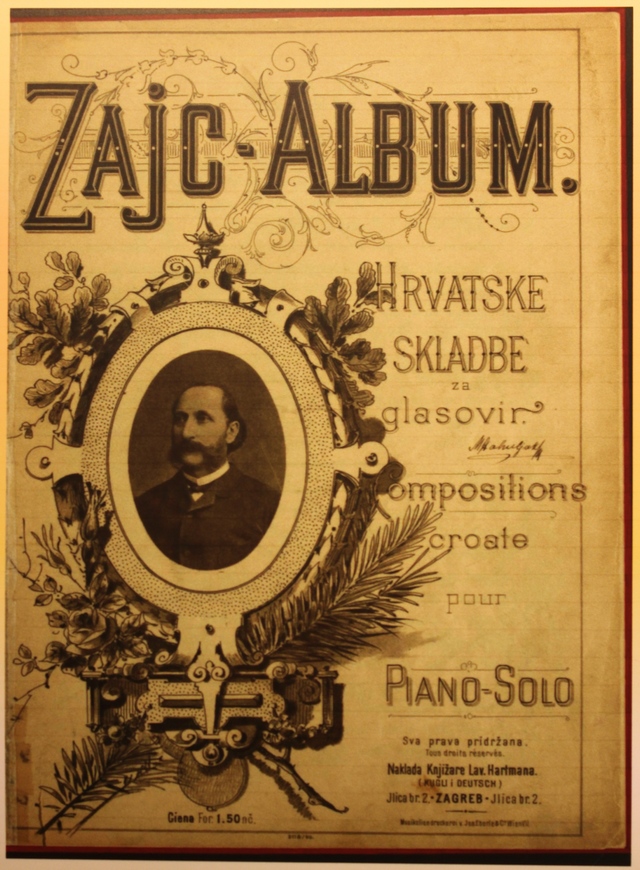
Ivan pl. Zajc: Hrvaske skladbe za glasovir, Zagreb 1890.
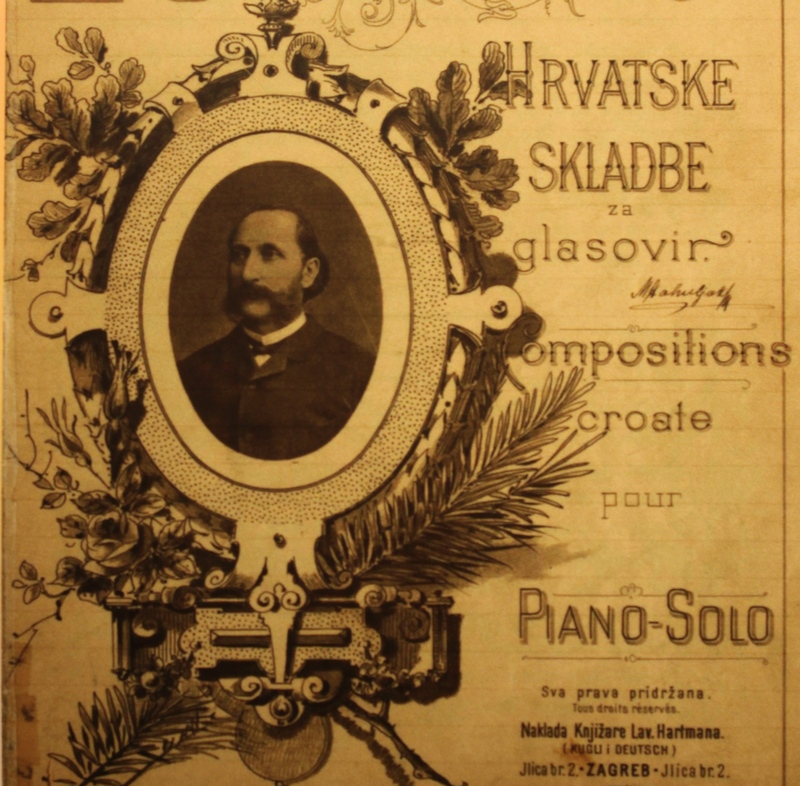
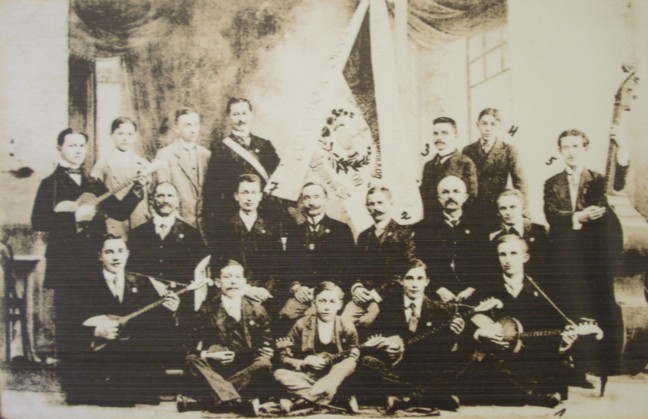
Tamburica orchestra from Bjelovar, around 1900.
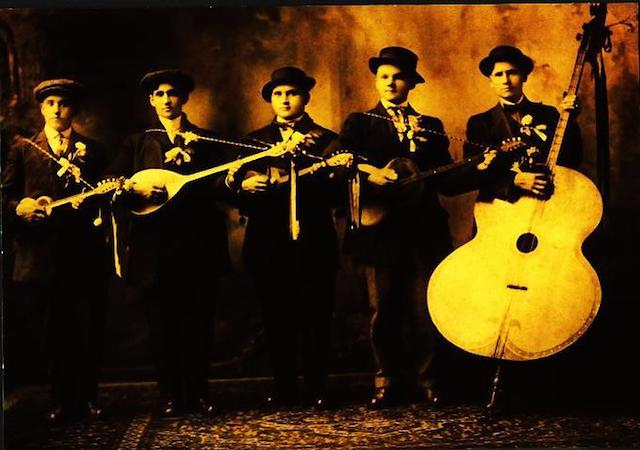
Old Tambura Band, Youngstown, Ohio, USA
Another jewel. Kajkavian verses by Dragutin Domjanić, music by Vlaho Paljetak (born in Dubrovnik!). Popevke sem slagal G
1. Popevke sem slagal,
Em D7 G E7
i rožice bral,
Am D7
i (v)su svoju radost
Am D7 G
sem drugim ja dal.
2. Al' žalost navek sem,
vu srcu ja skril,
ni nigdo me žalil,
i sam sem tak bil.
G G7
3. Al' v mojem srcu,
E7 Am
tam suzah vam ni,
Cm G Em
i če mi je teško
A7 D7 G
popevka zvoni.
Če siromak sem
se drugim bi dal
popevke i srce
i ne bu mi žal.
Vlaho Paljetak (1893-1944), born in Dubrovnik, left us beautiful verses and music in kajkavian language of the Croatian north-west. 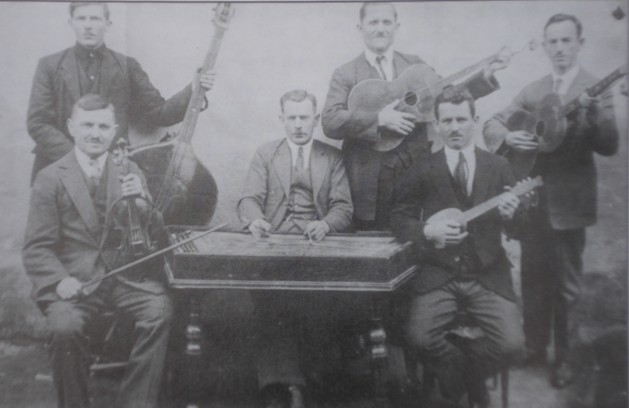
Vocinski tamburaski orkestar (Vocin tamburitza orchestra), 1928,
photo kept in Zavicajni muzej Slatina
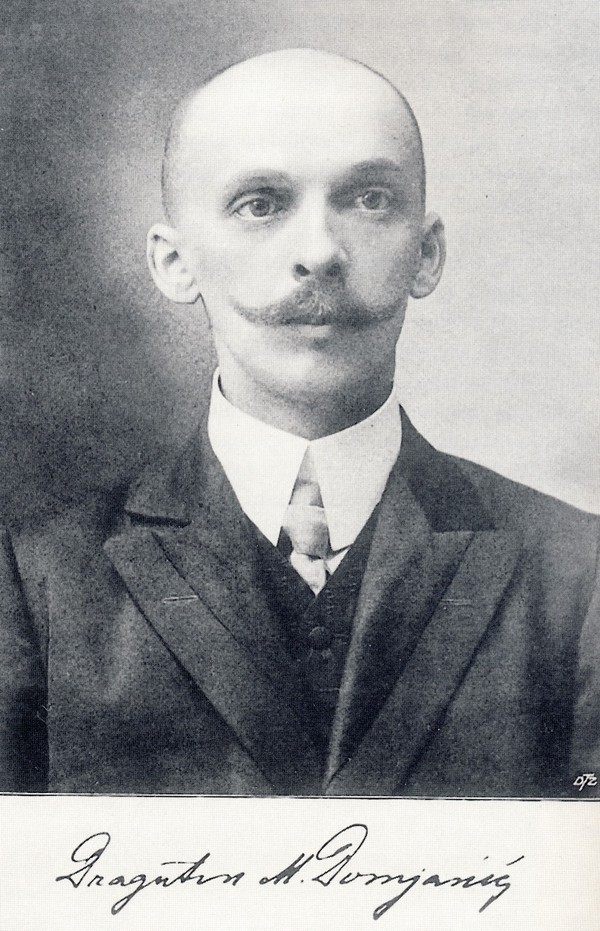
Dragutin Domjanić (1875-1933), a very popular kajkavian poet, wrote that according to their family tradition they stem from Bosnia. He was a stipendist of the cultural society Napredak from Bosnia and Herzegovina. See his verses1, verses2, verses3.
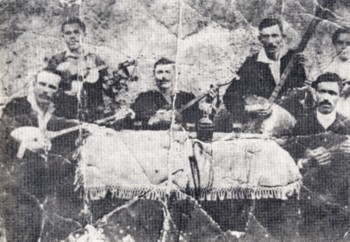
Tamburitza players from Virje from the turn of 19/ 20th centuries [Ivancan, p. 205]
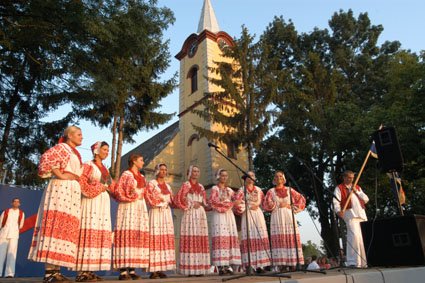
Many thanks to Ipik for very nice photos of Croatian national costumes.
Women in Croatian national costumes from the environs of Zagreb, Bocarski dom, Zagreb, 2006 (festival of Croatian gastronomy) 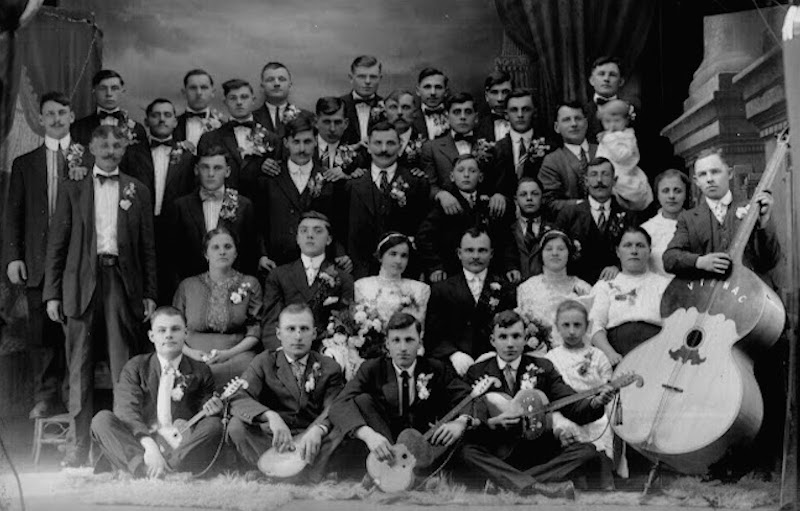
Croatian Tamburica Band at the wedding, ca 1930, USA
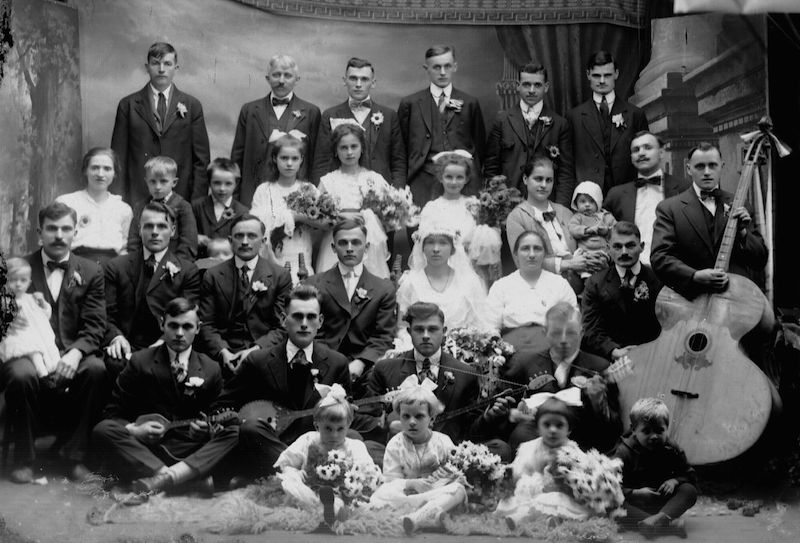
Croatian Tamburica Band at the wedding, ca 1930, USA. Source.
Fala Verses: Dragutin Domjanić, music: Vlaho Paljetak G C G
1. Za saku dobru reč,
C G0 G
kaj reči si mi znala!
Am D7
Za saki pogled tvoj,
A7 D7 D
za saki smeh tvoj fala!
2. Tak malo dobrega,
v živlenju tuj se najde.
I če je sunca trag,
za oblak tak i zajde.
G F E7 Am
3. Jer ti si srcu mi,
Am D7 G
tak puno sunca dala!
G F E7 Am
Kaj morem ti neg reč,
Am D7 G
od seg ti srca fala.
(repeat 3.)
Vlaho Paljetak (1893-1944), born in Dubrovnik, on the photo and on the stamp. The song has been rearranged by a well known conductor Emil Cosetto, on the occasion of Tito's death in 1980. It is regrettable that the message of this beautiful, innocent song has been so distorted. 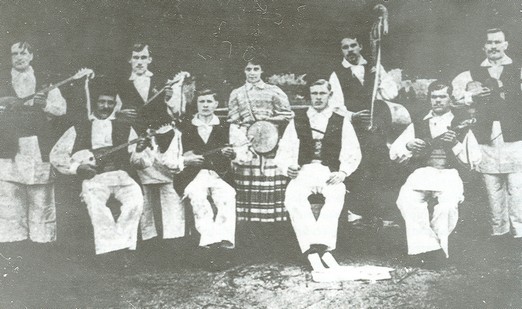
Hrvatsko pjevačko društvo "Lovor" founded in Slunj in 1876.
(Toma Žganec: Rastoke, Na slapovima Slunjčice, Zagreb 1990., str. 106)
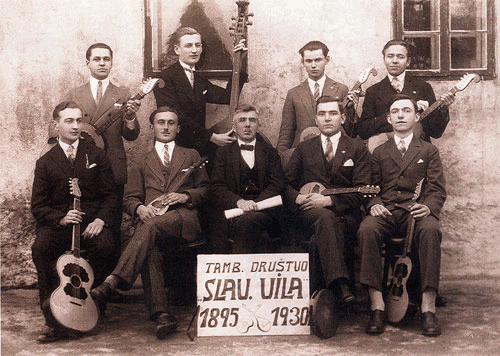
Tamburaško društvo Slavonska vila iz Orahovice, 1930, source.
Stoje: Ivica Grbić, Franjo Hocenski, Josip Filaković, Franjo Kikel.
Sjede: Ladislav Hocenski, Vencl Konopek, učitelj društva Viktor Albih (stolar),
Vlatko Voćinkić i Stjepan Bradač.
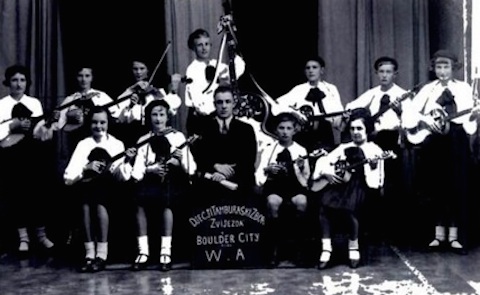 Dječji tamburaški zbor Zvijezda (Children Tamburitza Orchestra Star), Boulder City, West Australia, 1936. Source [ Šutalo, p. 209]. 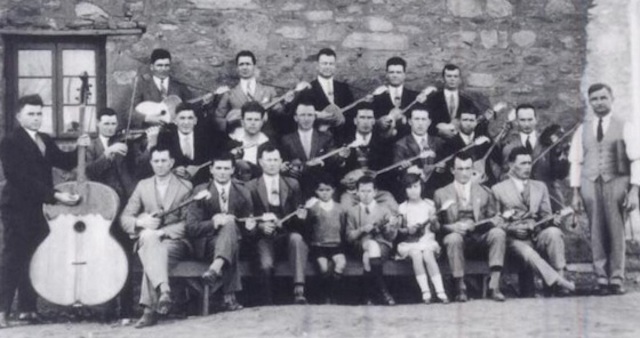 Croatian Tamburitza Orchestra Broken Hill, New South Wales, Australia, 1929. Source [ Šutalo, p. 204]. 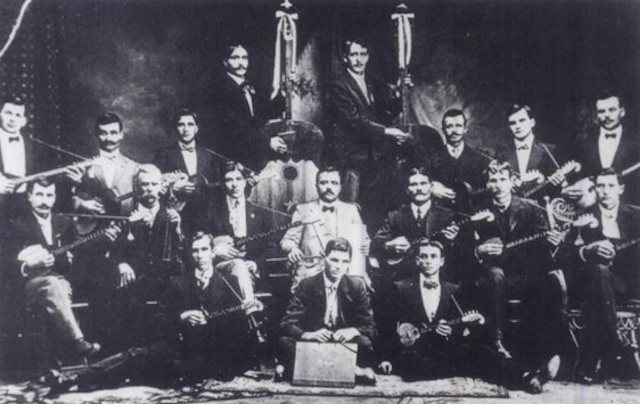 Croatian Tamburitza Orchestra Boulder, Western Australia, 1910. Source [ Šutalo, p. 204].
Marijana Verses and music: Vlaho Paljetak Scores: JPG1, JPG2 It is interesting and little known that in Japan there exist two recordings of Vlaho Paljetak's well known song Marijana - in the Japanese language, and the song was very popular in that country! We invite you to listen to Vlaho Paljetak's tune O, MARIJANA, sung by Seiji Tanaka in Japanese and Croatian, recorded in 1976: By the courtesy of Dr. Drago Stambuk, Croatian ambassador in Tokyo. I had opportunity to listen them on two records issued in Japan, when I visited Mr. Mario Kinel in his apartment in Zagreb (Mr. Kinel was a well known pop-music composer and translator; he even translated Vu plavem trnaci into Italian and German). Of course, out of Japanese verses I understood only - Marijana. 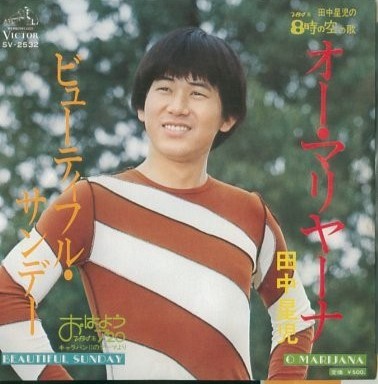
O Marijana (see bottom on the right), issued in Japan in1976, sung by Seiji Tanaka, Japanese pop singer born in 1947. Marijana is also very popular in Czechia. It was included in both Croatian original and Czech translation into the book "Sveove Evergreeny" (World's Evergreens), published in Prague in 2000 (Petr Jansky - MUSIC CHEB). Except in Czech and Japanese, Marijana has been translated and sung in Italian, German, Russian, and Romanian. In addition to this, I learned that a famous american actor Harry Dean Stanton ("Texas Paris Texas") sang the whole Marijana in superb Croatian to Mr Nenad Bach (personal information by Mr Nenad Bach).
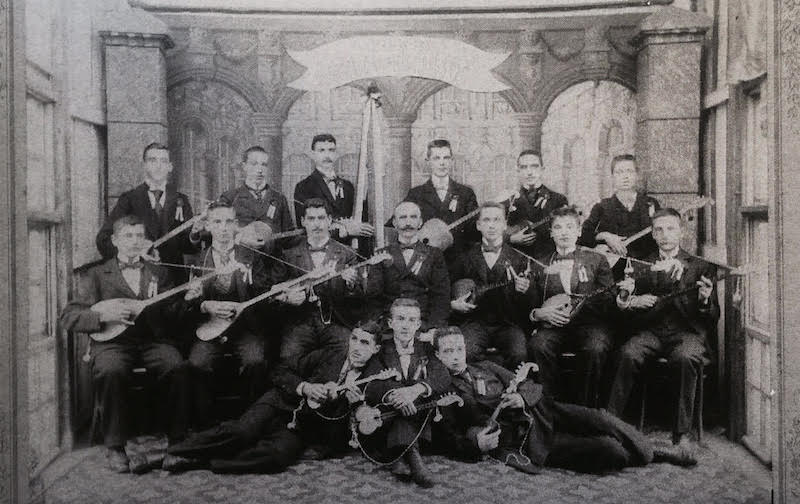
Gundulić tamburitza orchestra in Dubrovnik, arround 1898. Source [Miho Demović, Glazba i glazbenici
na području bivše Dubrovačke Republike za vrijeme austrijske uprave 1814.-1914., p 111].
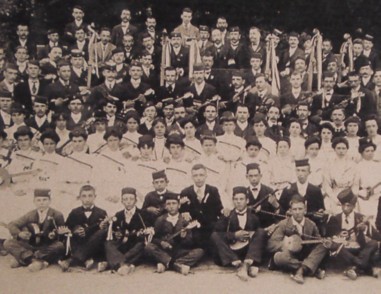
United choirs of the Kastav region near Rijeka, 1908
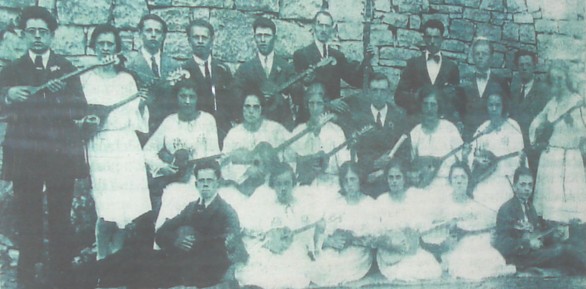
Tamburitza orchestra Spinčići in Kastav, 1922
Omaha Tamburitzans, USA
I know it would be a fatal mistake not to provide an example for the people from Dalmatia (they are quite sensitive). Here is a nice back-cycling: C#7 -> F#m -> B7 -> E Try to harmonize the rest of this exceptional song yourself. S ponistre se vidi Šolta text: Zdenko Runjić
music: Oliver Dragojević E
Šoto voce piva klapa,
C#7 F#m
u to gluho litnje doba,
B7
i prolazi ispod skala
F#m B7 E
di se suši tvoja roba.
Do pergula riči lete,
tu se misec smije gradu.
Ti se dižeš iz kočeta,
da poslušaš serenadu.
C#7 F#m ...
S ponistre se vidi Šolta,
piva klapa ispod volta.
U daljini svitle koče,
piva klapa šoto voce.
Ti se ozireš po sobi,
slika je na kantunalu,
onceg ća ga more odni
u dalekem fortunalu.
Opustila davno riva,
zatvoreni su portuni.
Šoto voce klapa piva,
tvoji mirišu lancuni.
Tiho razmičeš koltrinu,
zrila si ka litnje voće,
o ljubavi i o vinu,
piva klapa šoto voce.
S ponistre se vidi Šolta,
piva klapa ispod volta.
U daljini svitle koće,
piva klapa šoto voce.
Niko neće te kaštigat,
kad bi skinila korotu.
Život che te svu deštigat,
A još moreš dat lipotu.
S ponistre se vidi Šolta,
žmiga svitlo ispod volta.
U po volta kada pasa,
piva klapa ispod glasa.
By the way, don't miss the following beautiful Dalmatian klapa songs web site. Chapeau! See also another klapa songs web site. 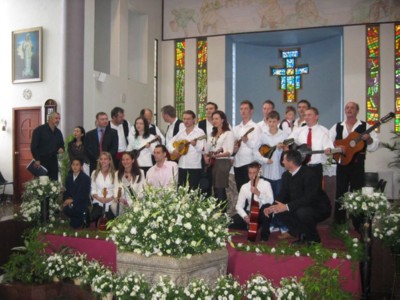
Tamburitza orchestra performing after Easter Mass 2006 in South Africa
(many thanks to Mr Ivo Lusic, Johannesburg)
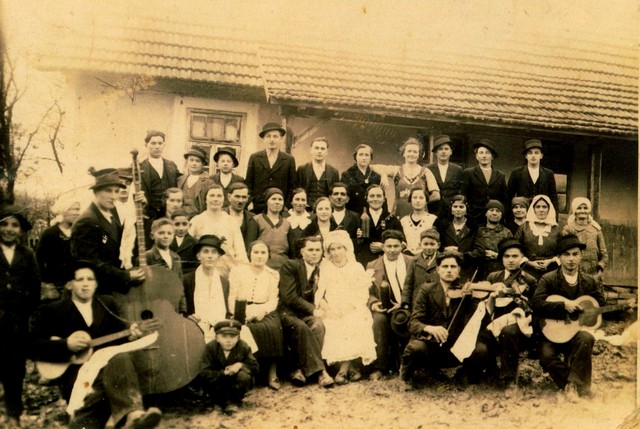
Wedding in the village of Samarica, Moslavina, North of Croatia
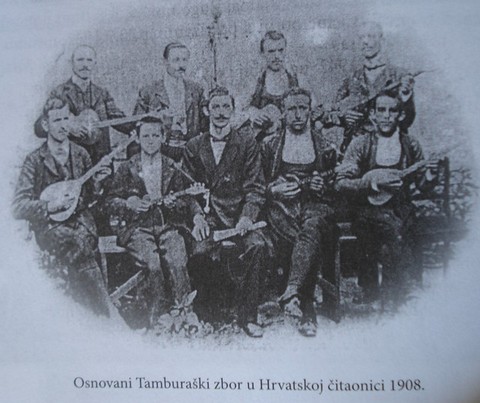
Tamburitza orchestra in the Croatian reading room in 1908 in Bugojno, Bosnia and Herzegovina.
Source Antun Lučić ed.: S Napretkom kroz stoljeće 1906.-2006., HKD Napredak, Bugojno 2006. ISBN 978-9958-9134-0-2
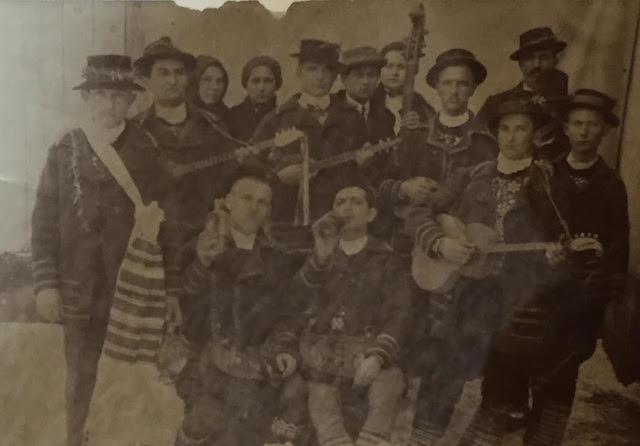
Tamburica orchestra in the town of Županja, from the beginning of the 20th century.
The further step in harmonization would be to describe possible alterations within the same (constant) chord, which in fact leads to the jazz harmony. This can be applied even to such a simple song as: Sinoć kad sam ti proša A Aj7 A6 Aj7
Sinoć kad sam ti proša,
A Aj7 F#7 Bm E
mimo te bile dvore vidim te dušo Mare.
D E
Vidim te dušo Mare,
E7 A
di s drugim govoriš.
....
which sounds very nice. Here Aj7 stands for Amaj7. Note the back-cycling here too, which is essentially: F#7 -> Bm -> E -> E 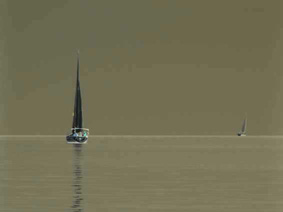
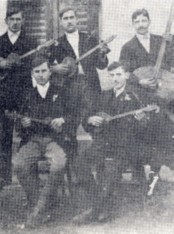
Tamburitza orchestra conducted by left-handed player Antun Kranjec,
Molve 1918 [Ivancan, p. 196]
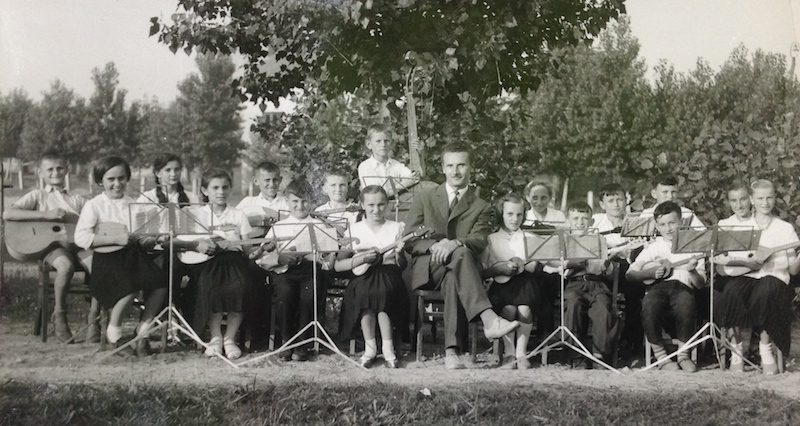
Dragutin Božić, schoolteacher with his class in Molve, 1961. Music instruments produced by the Kos family enterprise in Pitomača.
Rudolf Fizir, the greatest Croatian constructor of airplanes, playing bas in the Tamburitza Orchestra Šenoa as a student of the Crafts School in Zagreb. 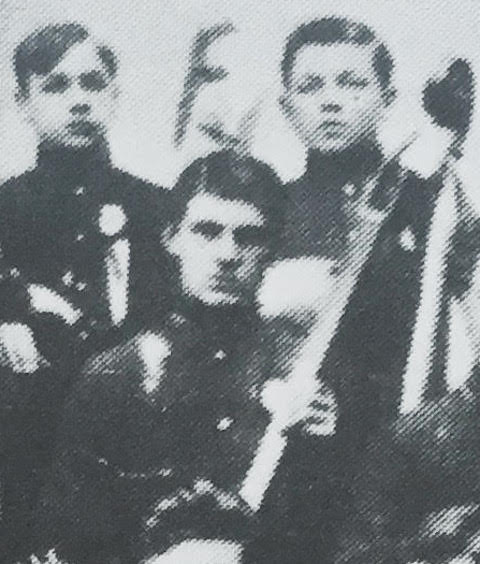 Young basist Rudolf Fizir among tamburitza players in Zagreb. 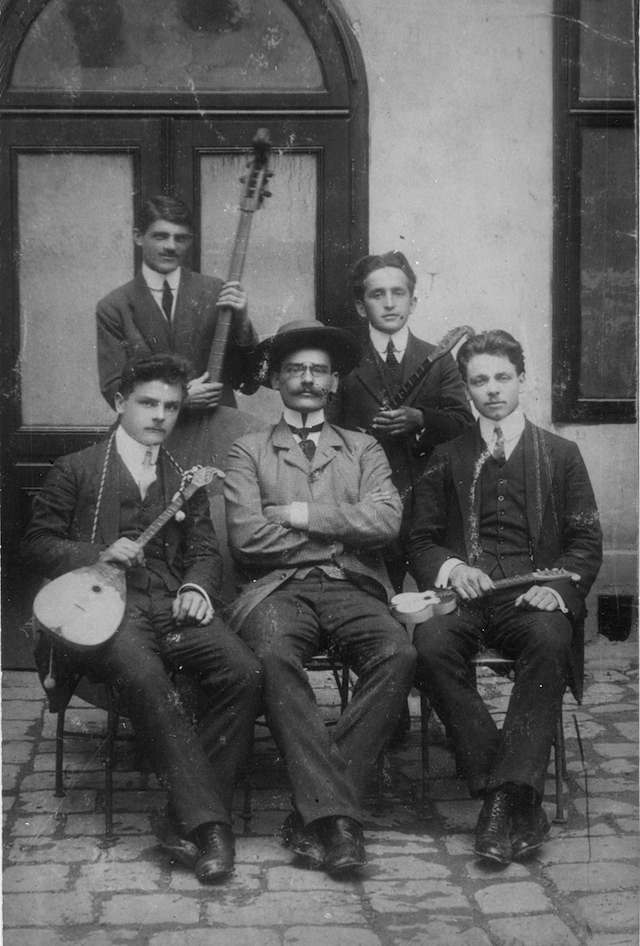 Rudolf Fizir Rudolf Fizir with his bas among Croatian tamburitza players in Wiener Neustadt in Austria.
Of course, many songs do not `tolerate' excessive harmonization, which is probably the case with the above song too. Another `extreme' is for instance Vu plavem trnaci, a real (harmonic) challenge. I like this song very much.
Vu plavem trnaci 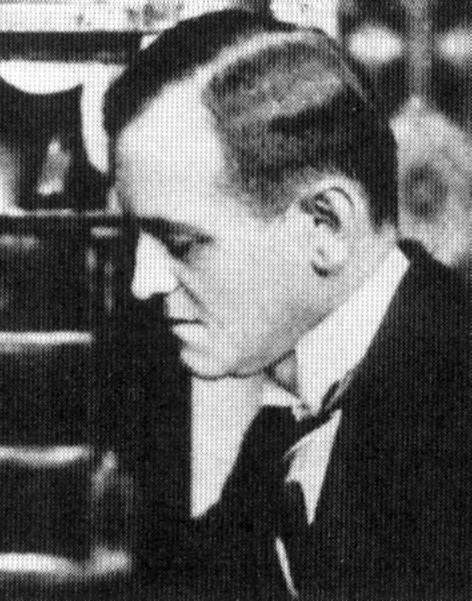 G Gm AmD7 G
1. Vu plavem trnaci mi hiža stoji,
G D A7 D
od zelenih vejah je videti ni.
C D7 G Gm AmD7 G
Bogica je z'dreva, ne vufa se reva
G0 G Em Am D7 G
pokazat pred ljudmi kak da se boji.
Em Am B7 Em
Vre slaba je, stara prek stotinu let,
F# B F# B
od njezine brajde posušil se cvet.
Am B7 Am B7
Od blata je zbita, i škopom pokrita,
Am Em C B7
ne moreš prav znati je'l hiža il' klet.
Am D7 G Em
Nju muški su žuli prinesli na svet,
Am D7 G G7
za onda dok Zagorec bil je još kmet.
Am D7 C0 Em
I bila je bela, i z'mirom vesela, |
D#7 G Em AmD7 G | 2x
a danas od tuge se hoće podret. |
2. I vnogi se lajtić vu njoj je ispil,
plebanuš, vučitelj tu vinček je pil!
Z gosponom pogaču i orehovnjaču
je mužek rad drobil i srećen je bil.
Pod malim oblčcekom fantić je stal,
prelubleno dekle potiho je zval.
I vnogi je pušlec zamenil za kušlec,
i morti je fantić v komori i spal.
V toj hiži se rodil je vnogi vojak,
i vsaki je sledni bil pravi junak!
Za tujca vojeval i krv je proleval,
za falu su rekli mu da je bedak!
3. I hižica tiha ščekuje on čas,
kad jenkrat i Zagorcu došel bu spas!
Na oko je tiha, al veter zmir njiha,
vu vejah šumechih starinski jen glas:
em Zagorcu samo je Zagorje raj,
nigdar nebu zabil govoriti kaj.
Dok krv je proleval on zmir je popeval:
Še jenkrat bi rad videl zagorski kraj!
Pretrpel je muke črez jezero let,
al zopet bu brajda potirala cvet.
Iz našega gorja vre javla se zorja,
vesela i srećna bu hizza i klet!
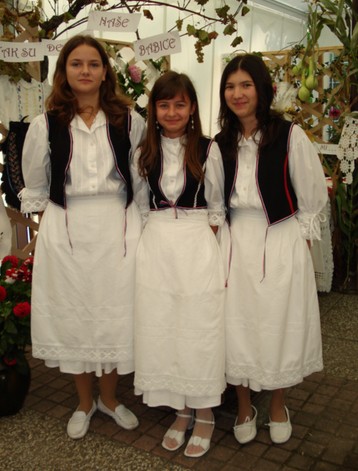
Milan Grakalić (Medulin, 1909 - 1979), an excellent Croatian guitarist (and architect), has arranged Vu plavem trnaci for classical guitar, see the scores. For more details see Andrija Tomasek: "Vu plavem trnaci", Matis d.o.o. Pregrada, 2005, ISBN: 953-96561-9-2. Many thanks to Professor Tomasek for scores. 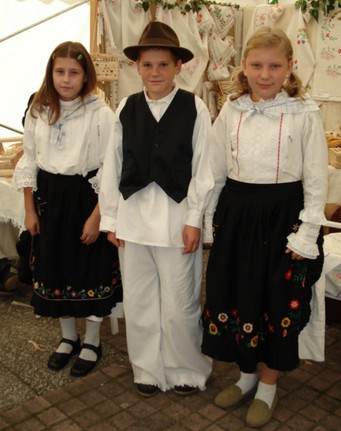
When you visit the castle of Veliki Tabor, don't miss to see the room devoted to Gjuro Prejac, who was born in the nearby village of Desinic. 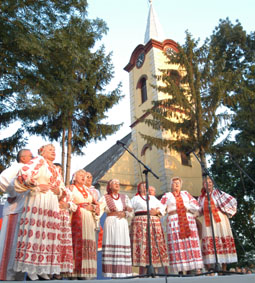
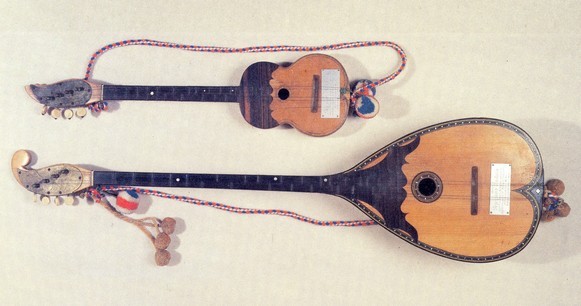
Tamburitzas of Stjepan Radic, source [Tomicic]
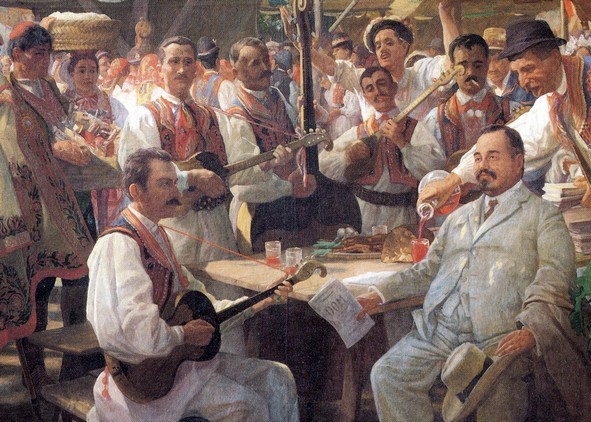
Stjepan Radic with Croatian peasants in Zagreb, source [Tomicic]
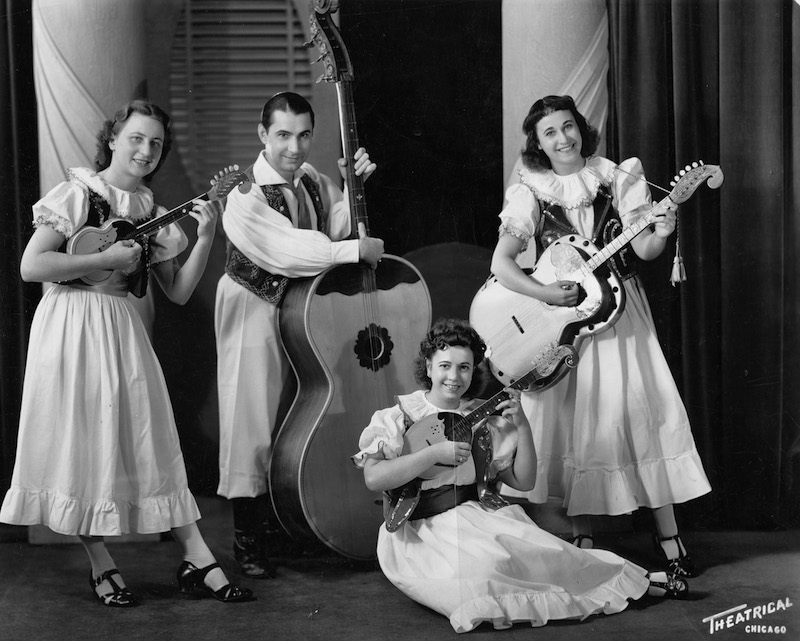
The Elias Tamburitzans, also known as the Croatian Tamburitza Ensemble, existing probably between the two World Wars. Left to Right: Martha Elias, Charles Elias, Mary Filipovich, Anne Elias. Source: Helene Stratman-Thomas Collection, Mills Music Library, University of Wisconsin-Madison. See James P. Leary and Folksongs of Another America.
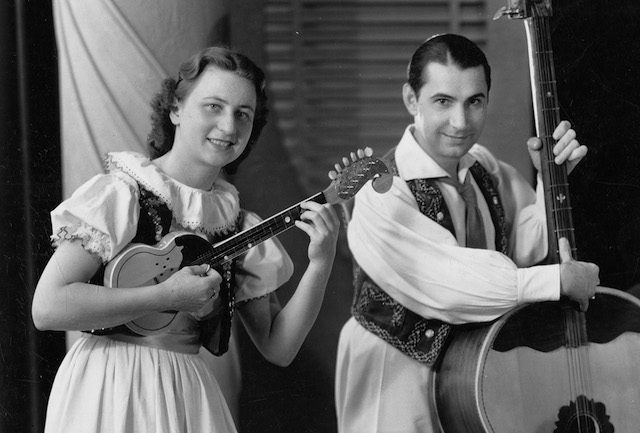
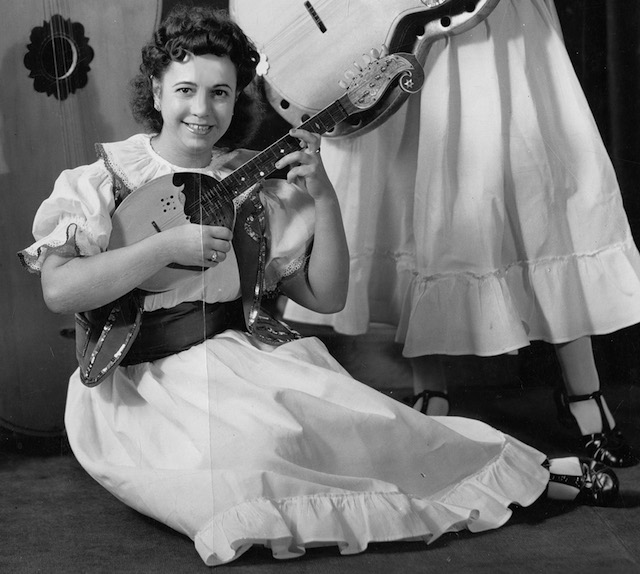
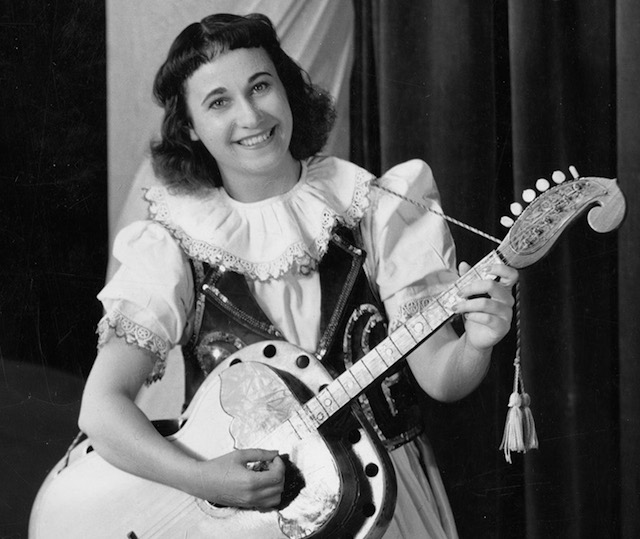
The accompaniment of the following very nice song can be also be ``sprinkled' with back-cycling: Em -> A7 -> D, or B7 -> Em -> A7 -> D. Oj, jesenske duge noći Ivan Trnski D Em A7 D
Oj, jesenske duge noći, oj!
D B7 Em A7
Oj, jesenske duge noći,
D A7 D
reko dragi da će dochi, oj!
D A7 D
Čuj me dragi čuj!
(repeat last three lines)
....
In the third line you may also use back-cycling: D Bm Em A7 D
reko dragi da će doći, oj!
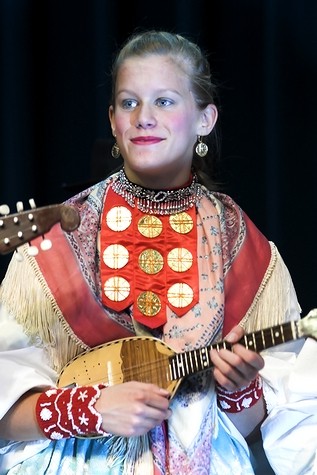
CroatiaFest 2005, Seattle, USA, Photo - Jal Schrof
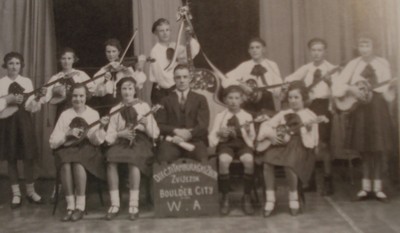
Children's tamburica orchestra Zvijezda (Star) in Boulder City, Western Australia, 1936, see [Sutalo]
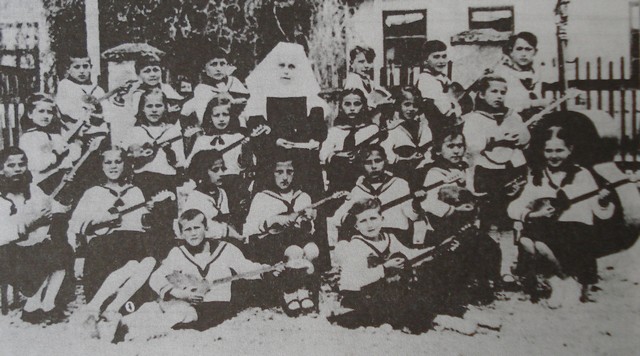
Tamburitza orchestra in Bugojno, Bosnia and Herzegovina, in the first half of 20th century, directed by a nun.
Note that there are many girls. Source [Antun Lučić ed.]
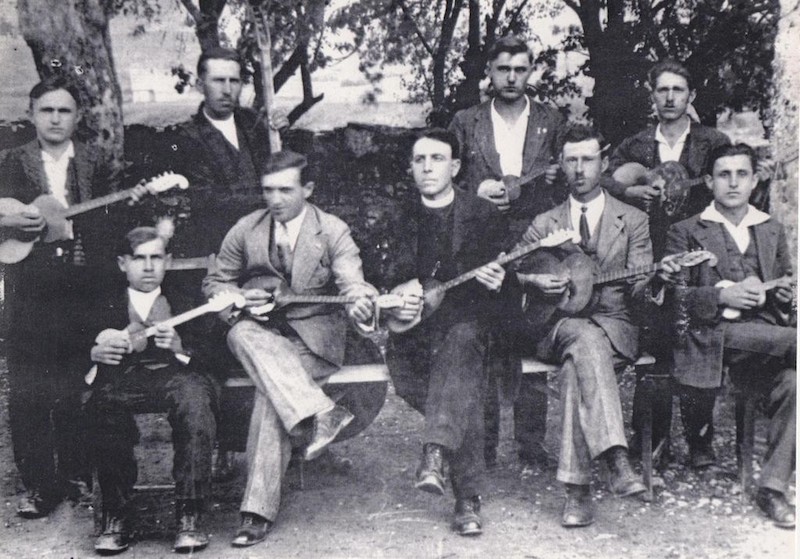
Saborsko tamburitza orchestra in 1930s, Gorski Kotar, Croatia. Standing: Ivan Špehar (Zec), Josip Grdić (Ćilim), Petar Sertić (Pera Mašin), Vuković Mate (Mateša). Sitting: Nikola Špehar, Slavko Katušin - teacher in Saborsko, Joso Vukelić - Catholic priest in Saborsko, Marko Grdić (Markica Josin), Pave Vuković (Maljićev). Source of the photo Saborčanski tamburaški zbor iz 30-tih godina prošlog stoljeća.
Ima jedna kućica Text: Vinko Kos, music: Jakov Gotovac A
Ima jedna kućica
D
draga srcu mom.
D E A
Ta kućica pod lipom |
E D (A) | 2x
stari je moj dom. |
U njoj živi majčica
dobar otac moj.
A i meni najljepše
živjet je u njoj. Kućo draga kućice
čuvao te Bog,
jak i vjeran branitelj
starog doma mog. 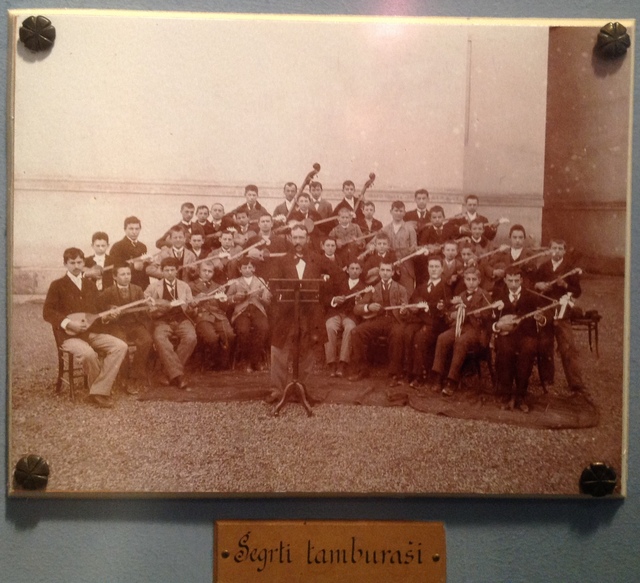
Photo of young Croatian entrepreneurs - Tamburitzans, exhibited in the Croatian School Museum (Hrvatski školski muzej) in Zagreb.
The photo is probably from approx. 1900.
Ova pjesma se u Hrvatskoj do godine 1945. pjevala na stari način. Nakon 1945. nije se smjela pjevati ili pojavljivati u knjigama u tom obliku (radi "čuvao te Bog"). Da bi pjesma bila spašena, unesena je preinaka u zadnjoj kitici. Složio ju je Velimir Žubrinić, učitelj i ravnatelj OŠ u Kozjaku, malom selu kod Krapine, zajedno sa svojom suprugom Katicom rođ. Suntešić: Kućo draga kućice,
mili dome moj,
bit će vjeran branitelj
tebi sinak tvoj.
Katica Suntešić je kao dijete tu pjesmu naučila godine 1942. od svoje učiteljice Štefice Rubin u osnovnoj školi u Svetom Križu Začretje (Štefica Rubin, židvoskog podrijetla, tragično je stradala 1943. prigodom partizanskog napada na vlak na putu za Zagreb). Usmenom predajom ta se inačica vrlo brzo proširila ne samo u Hrvatskoj, nego i izvan domovine, pa i među Hrvatima SAD-a koji znadu čini se samo ovu drugu inačicu. Autori teksta i melodije izvorne pjesme nisu nam poznati. Sadržaj pjesme "Ima jedna kućica" nudi prekrasne motive za domoljublje i likovno izražavanje djece. Treba zahvaliti učiteljici Štefici Rubin što je djecu u školi učila tu pjesmu, te roditeljima Katice Suntešić, Barici i Petru, koji su joj usadili ljubav prema pjesmi. Zanimljivo je da se obje inačice navode u knjizi [Duša narodna], na str. 51 i 88. O toj pjesmi govori istaknuta hrvatska pjevačica Lada Kos u filmu Neprijatelj naroda redateljice Višnje Starešine. Test pjesme je napisao njezin otac Vinko Kos (1914.-1945.), koji je stradao na Križnom putu. 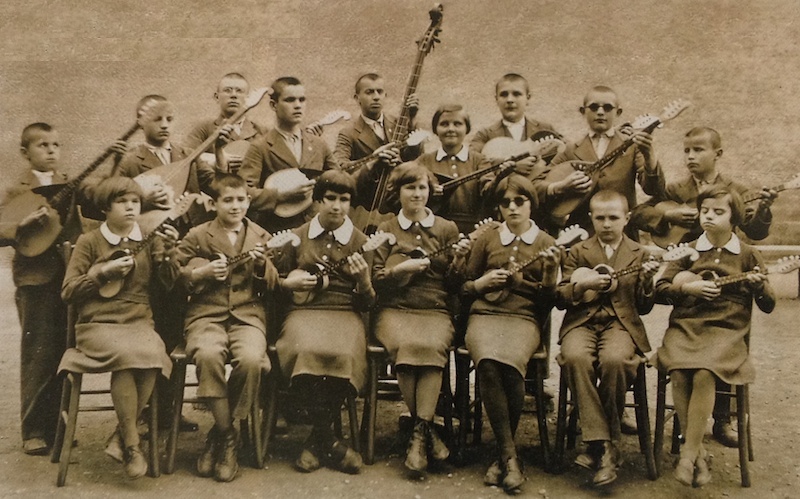 Blind tamburitza players in Zagreb, from the School "Vinko Bek" for blind children. Photo from arround 1920. 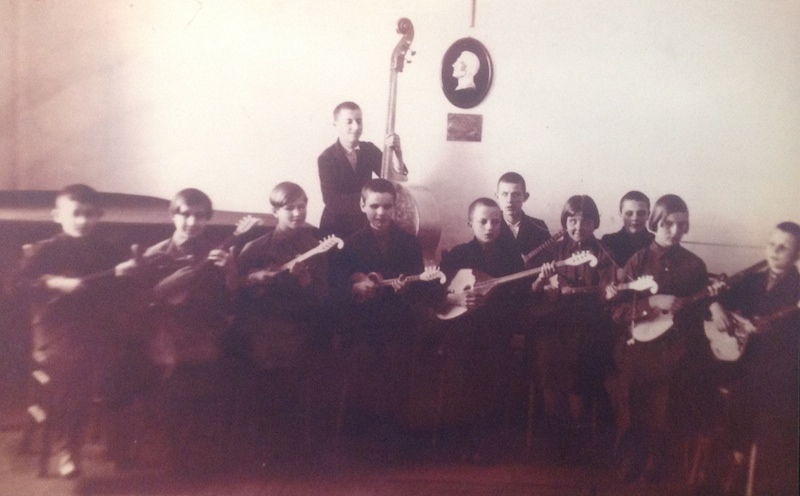 Blind tamburitza players from the School "Vinko Bek" for blind children. Photo from arround 1920, exhibited in the Typhlological Museum in Zagreb.
 Kad se Tena udavala G B7
1. Kad se Tena udavala,
C D7 G
od čaše se nisam mako.
G B7
žalio sam sudbu svoju,
C D7 G
Danima sam stalno plako.
Refrain (2x):
G B7 C
Udaše mi moju Tenu,
Am D7 G
Doveli i tamburaše,
G E7 Am
Meni osta samo želja
Am D7 G
I neispijene čaše.
2. Majka vicce: Što si bisan,
zašto konje tučeš sine?
Pa i drugih cura ima,
sve su lipe sve su fine.
2xR.
Many thanks to Mr. Darko Varga for having contributed nice photos representing national costumes from the village of Draz (Baranja near Danube river). 
Ivanovci, Slavonija, Croatia, from the blessing ceremony of installing two church bells made in Innsbruck, Austria, 2006.
The ceremony has been led by bishop Marin Srakić, born in that village.
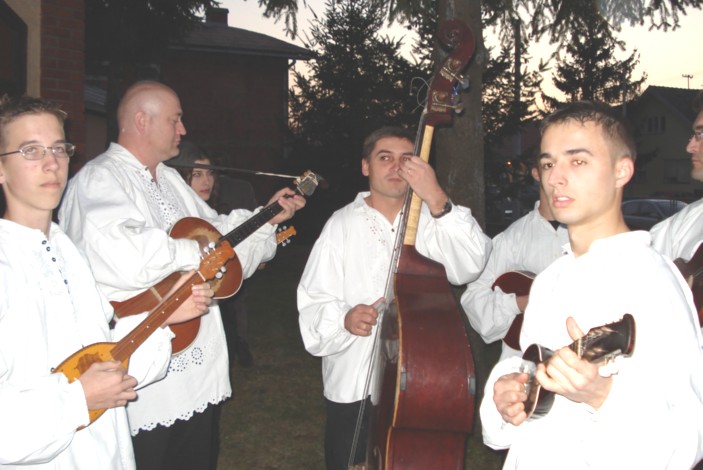
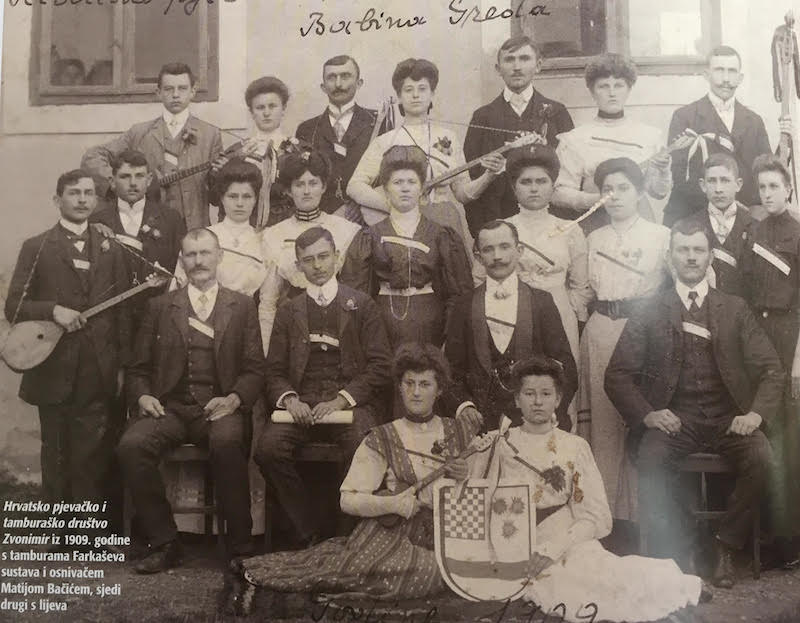
Hrvatsko pjevačko tamburaško društvo "Zvonimir", Babina Greda, 1909. (Croatian singing and tamburitza society "Zvonimir", from Babina Greda, 1909). Source Mihael Ferić: Hrvatski tamburaški brevijar / The Croatian Tambura Breviary, Šokadija, Zagreb, 2011., fascinating book with 1300 photos on 500 pp. Two girls are sitting by the Croatian Coat of Arms.
|